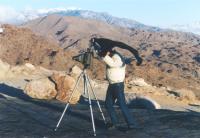
By Q.-Tuan Luong for the Large Format Page
Summary: This article explains what large format photography is about, and weights the advantages and disadvantages of using a large format camera. It also provides references for further information.
With a few notable exceptions, these cameras share the following characteristics:
This is a photograph of my friend Charles attempting to use a darkcloth for focus and composition on a 8x10 . 40 mph winds were just a little to strong for the darkcloth. He ended up using the viewfinder and foot scale with this 300 mm setup. Mark Cieslikowski
What is the real gain compared to other formats ?
The consensus seems to be that as far as enlargements are concerned,
the difference between 4x5 and 35mm is huge, but that the
difference
between 4x5 and 6x7 will show up only in big enlargements, 16x20 or
larger. At 16x20 modern LF lenses have a slight edge due to reduced
granularity and high contrast, above that, modern 4x5 wins due to
granularity. However, you will see a bigger difference with format for
B&W prints than with color prints.
On the other hand, a contact print
has a special quality that some feel cannot be obtained by an enlargement.
Contact printing is also the only way to work with some alternative
process such as paladium/platinium, carbon, etc...
Will I have to sell the house ?
Large format photography is actually not that expensive, especially
compared to medium format photography (the prices for the 35mm market
are influenced by the fact that it is quite consumer-oriented), and a
good large format system can be built for no more than a good modern
medium format system. There is also possibility to do large format on
a budget. A fairly good 4x5 can be bought used for less than $500, and
if you are willing to accept some limitations, you can get something
which works for a couple hundred of dollars. The latest lenses are
indeed very expensive, on the other hand there are a number of older
lenses which are really inexpensive, a couple of hundred dollars or less.
Most of the lenses will be totally appropriate for B&W work. They don't
have to be as sharp as lenses for smaller formats.
Modern lenses, which will produce results virtually indistinguishable
from the the latest designs, can be bought used for a rather
reasonnable price. Since LF systems are usually not submitted to an heavy
use like smaller formats, gear which is decades old will usually work
fine. A great news is that as you have built a good set
of lenses, when you upgrade to a better camera, you just keep them,
and maybe change the lensboards. At one point I was hesitating between
the Pentax 67 (one of the cheapest MF systems) and 4x5. One of the
reasons which got me decided for the 4x5 was that the price of the 4x5
system was a little lower.
Film looks expensive too, but you won't shoot as
many images as you used to. If you do color, you'll probably have to have
your film processed by a lab. The total cost of a 4x5 Velvia (film+processing)
is less than $4, the cost of a 5x7 less than $8. On the other hand, B&W film
home processed is quite cheap.
Journals:
There is only one journal devoted exclusively to large format: View Camera TM, published by Steve Simmons (Largformat@aol.com). The quality has been overall high compared to the mainstream magazines. Over the past few years, the magazine has concentrated on interviews and portfolios, in which the emphasis is on vision and photographs, rather than technique. Earlier in its history, the journal had more technical articles, but because it tries not to rehash topics which had been already published, the information really useful for LF beginners is limited in current issues. You could order back issues, but if you're after technical basic material, you'd certainly be better served by books.
Although not exclusively devoted to LF, Photo Techniques (USA) regulary runs more detailed reviews of LF equipment written by actual users, as well as excellent how-to articles on LF techniques.
Web Discussion forums: The LF Q&A forum associated on this site has proven to be the best place on the internet for discussion of LF related issues. It is very focussed, yet has the most active participation of any LF bulletin boards on the web. Other LF discussion forums on the web include: f32.net, photo.net, graflex.org, view camera, apug.org.
Usenet: The newsgroup: rec.photo.equipment.large-format dedicated exclusively to LF photography is one of the best places on the internet to discuss. This newsgroup is one of the most civil on Usenet, but still, it is unmoderated, so flame wars occur from time to time.
Mailing lists There used to be a mailing list, the "Large Format Digest", discontinued since the creation of the previously mentioned newsgroup. Besides reading it from the web, you can subscribe to the LF Q&A forum to read it by email.
PS. I started large format photography in 1993. There were a lot of things which were mysterious back then. After shooting thousands sheets of film, some of them are still mysterious, but I have beneficiated from advice of really knowlegeable persons on the net. I wrote this series in order to try and give back by answering the questions that I was myself asking a couple of years ago. It is written with location and field photography in mind. I have only very little knowledge about studio work.